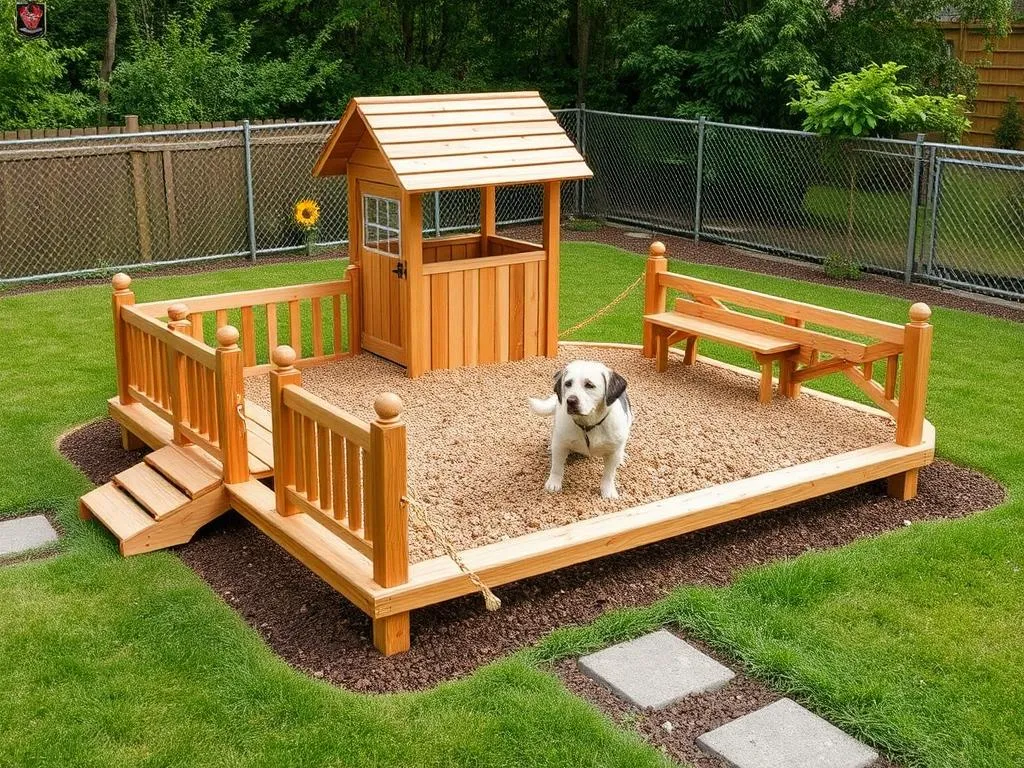
Introduction
Creating a DIY dog playground is a fantastic way to ensure that your furry friends have a dedicated space to play, exercise, and explore. With the hustle and bustle of modern life, it’s easy for our dogs to become bored or anxious without enough physical activity or mental stimulation. A well-planned playground can provide numerous benefits, including enhanced physical health, mental engagement, and enriched bonding time between you and your pet.
When embarking on this exciting project, it’s crucial to prioritize planning and safety. From assessing your dog’s needs to choosing the right materials, each step is essential for creating a safe and enjoyable environment. In this guide, we will delve into DIY dog playground plans that cater to various breeds, sizes, and play preferences, ensuring that your dog has the best playground experience possible.
Understanding Your Dog’s Needs
Assessing Your Dog’s Breed and Size
Understanding your dog’s breed and size is fundamental when designing a playground. Different breeds have varying activity levels and play styles. For example, a Border Collie will require more physical challenges than a Bulldog. Larger breeds may need sturdier equipment, while smaller breeds can benefit from scaled-down features. As you develop your DIY dog playground plans, consider the following:
- High-Energy Breeds: Breeds like Labrador Retrievers and Australian Shepherds thrive in active environments and will need ample space to run and play.
- Low-Energy Breeds: Breeds such as Shih Tzus or Basset Hounds may prefer gentle play, requiring less intense equipment.
Identifying Your Dog’s Play Preferences
Each dog has unique play preferences that can influence the design of your playground. Observing your dog’s behavior during playtime can help you tailor the playground to their tastes. Here are some common types of play:
- Chasing: Dogs love to run after balls or frisbees.
- Fetching: Incorporate fetch zones with safe, soft materials.
- Climbing: Some dogs enjoy climbing on structures like ramps and logs.
By understanding what excites your dog, you can create an engaging environment that keeps them active and happy.
Safety Considerations
Safety should always be at the forefront of your planning. Here are some common hazards to avoid:
- Sharp Edges: Ensure all equipment has smooth edges to prevent injuries.
- Toxic Plants: Research any plants you incorporate into the playground to ensure they are non-toxic to dogs.
- Inadequate Fencing: A secure fence is essential to keep your dog safe and contained.
Planning Your DIY Dog Playground
Choosing the Right Location
Selecting the right location for your DIY dog playground plans is critical. Consider these factors:
- Sunlight and Shade: Ensure there’s a balance of sun and shade to keep your dog comfortable during play.
- Proximity to Distractions: Avoid placing the playground near busy streets or noisy areas that might distract or stress your dog.
- Space Requirements: Assess the space needed for various activities, keeping in mind the size and number of dogs that will use the playground.
Designing Your Playground Layout
A functional layout can greatly enhance your dog’s play experience. Here are some tips for creating an effective design:
- Visualize Different Zones: Create specific areas for play, rest, and agility training to keep activities organized.
- Flow of Movement: Ensure there’s enough space between equipment to allow for safe movement.
Budgeting for Your Project
Budgeting is an essential part of planning your dog playground. Here’s a basic cost breakdown of materials and tools you may need:
- Materials: Wood, PVC pipes, turf, and non-toxic paint.
- Tools: Hammer, saw, drill, and measuring tape.
To save money, consider sourcing materials from local hardware stores, online marketplaces, or even recycling old furniture and play equipment.
Essential Equipment and Features
Play Structures
Popular structures for a dog playground include tunnels, ramps, and climbing walls. Here’s how you can create these features:
- Tunnels: Use PVC pipes or purchase flexible tunnels that can be easily assembled and disassembled.
- Ramps: Build ramps from sturdy wood, ensuring they are wide enough for your dog to navigate safely.
- Climbing Walls: If you’re feeling ambitious, consider constructing a small climbing wall using plywood and non-slip grips.
Agility Equipment
Agility training is essential for keeping dogs mentally and physically stimulated. Here are some DIY dog playground plans for agility equipment:
- Jumps: Create jumps using PVC pipes or wooden planks, adjusting the height based on your dog’s ability.
- Weave Poles: Set up a series of vertical poles in a straight line for your dog to navigate through.
- Seesaws: Construct a seesaw using a long plank and a sturdy base, ensuring it’s stable and balanced.
Enrichment Features
Incorporating enrichment features can make your dog playground unique. Here are some ideas:
- Water Features: Install a small kiddie pool or a splash pad for water-loving dogs.
- Digging Areas: Create a designated digging pit filled with sand or soil for dogs to explore.
- Natural Elements: Use logs, rocks, and other natural materials to encourage exploration and play.
Step-by-Step Guide to Building Your Dog Playground
Gathering Materials and Tools
Before you start building, gather all necessary materials and tools. Here’s a list to help you get started:
- Essential Tools: Hammer, saw, drill, level, and measuring tape.
- Recommended Materials: Plywood, PVC pipes, non-toxic paint, and durable fencing.
Step-by-Step Construction Process
Here’s a simplified construction process for building a basic playground feature:
- Choose Your Feature: Decide whether you want to build a ramp, tunnel, or agility jump.
- Measure and Cut: Measure your materials based on your design and carefully cut them to size.
- Assemble: Use screws or nails to assemble the parts, ensuring everything is secure and stable.
- Safety Check: Inspect the feature for any sharp edges or potential hazards before allowing your dog to use it.
Adding Finishing Touches
Finishing touches can enhance the overall appeal of your playground:
- Painting: Use non-toxic, outdoor paint to add color to your structures.
- Landscaping: Plant dog-friendly plants or lay down soft turf to create a comfortable environment.
Maintenance and Upkeep
Regular Inspections
To ensure the longevity of your playground, regular inspections are vital. Check for:
- Wear and Tear: Look for signs of damage on equipment, such as splintering wood or loose screws.
- Stability: Ensure all structures remain sturdy and secure.
Cleaning and Safety
Keeping the playground clean is essential for your dog’s health. Here are some best practices:
- Regular Cleaning: Sweep the area and remove waste daily.
- Sanitizing Equipment: Use dog-safe cleaners to wipe down surfaces and toys regularly.
Updating Your Playground
As your dog grows or their interests change, consider updating your playground:
- Adding New Features: Introduce new equipment or enrichment areas to keep things exciting.
- Engagement: Rotate toys and structures to encourage ongoing play and exploration.
Engaging Your Dog in the Playground
Training Tips for Playground Use
Introducing your dog to new equipment can be an exciting experience. Here are a few tips:
- Positive Reinforcement: Use treats and praise to encourage your dog to explore new features.
- Slow Introduction: Allow your dog to approach equipment at their own pace to build confidence.
Playtime Activities and Games
Keep playtime fun and engaging with various activities:
- Fetch: Use different toys to keep fetch exciting.
- Hide and Seek: Hide treats or toys around the playground for your dog to find.
Monitoring Your Dog’s Behavior
Always supervise your dog during playtime to ensure their safety. Look for signs of:
- Overstimulation: If your dog seems overly excited or anxious, give them a break.
- Signs of Stress: Pay attention to body language; if your dog appears uncomfortable, it may be time to step back.
Conclusion
Building a DIY dog playground provides countless benefits, from promoting physical health to enhancing your dog’s mental well-being. With thoughtful planning and attention to safety, you can create an enriching environment that caters to your dog’s unique needs. So roll up your sleeves, gather your materials, and start planning your very own dog playground! Your furry friend will thank you for it!









